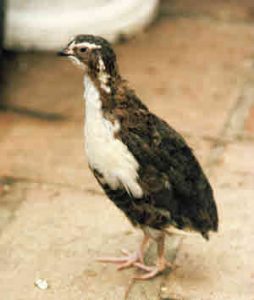 Coturnix Quail
Coturnix Quail
There is a great deal of confusion about the origin of Coturnix quail as we know them today, so it is appropriate to consider how their development took place. Part of the confusion undoubtedly lies in the fact that there are so many different local names, as well as old scientific names now replaced by modern classifications.
No one can know for certain how the various breeds and sub-species developed, but it is generally acknowledged that all the Coturnix types are originally based on the Common quail, Coturnix coturnix, the wild migratory bird of Europe, Asia and Africa.
Various sub-species developed from this, including the European quail, Coturnix coturnix coturnix, the Eurasian quail, Coturnix coturnix communis, and the Japanese quail, Coturnix coturnix japonica.
Also associated with the Common quail are the Stubble quail, Coturnix pectoralis, and the Brown quail, Coturnix ypsilophorus, of Australia. In India there is the Rain quail, Coturnix coromendelia, while Africa has the Harlequin quail, Coturnix delegorguei.
New Zealand once had its own variety of New Zealand quail, Coturnix novaezelandicae, but this is now extinct.
The Asian Blue and the African Blue are smaller members of the Coturnix family. These, like their larger cousins are now to be found in various sub-species and colour variations.
Coturnix Laying Quail
I use the term normal type Coturnix to indicate those birds that are normally kept commercially for the production of eggs or for the table. It also differentiates them from those Coturnix breeds that are kept as ornamentals, such as the Asian Blue.
Japanese Quail
The Japanese quail is the basis for most of the commercial quail that are now kept. It was first recognised in the nineteenth century as a separate breed in the wild, although it had been bred by the Japanese as a singing bird as early as the 12th century. In recent years, Japanese quail have been developed in more productive commercial strains, as well as for use in the laboratory.
Eurasian or Pharaoh Quail
The Eurasian or Pharaoh quail, Coturnix coturnix communis, has also contributed to the development of commercial strains in the USA. Coturnix breeds are often referred to as Old World Quail because they were introduced by European settlers, and it distinguishes them from indigenous New World Quail such as the Bobwhite.
These introductions had numerous names, including Pharaoh, Bible, Nile, Tsar, King, Mediterranean or German.
Size of Coturnix Quail
The normal type male Coturnix grows to around 16cm (6.5in), while the female is slightly larger at an average of 18cm (7.5in). Both sexes have dappled dark brown buff and cream striated backs, paler underbellies, breast and flanks.
In the female, the markings are less pronounced, while the male’s chest is reddish brown. This particular feature enables sex identification to take place from 3 weeks of age. Before then, it is difficult to do so.
In both sexes there is a distinctive light stripe above the eye, and a white collar, although this may be diminished in the female. The beak is yellow-brown to dark olive-brown, the legs pinkish yellow and the eyes dark brown. This description refers to the normal Coturnix laying quail. There are also varieties that differ in colour and markings.
This shortened article is taken from Keeping Quail, 4th Edition, by Katie Thear and used with permission of the publishers.
Further Articles on Keeping Quail
- Aviary Coturnix Quail – A guide to Aviary Coturnix Quail
- Chinese Coturnix Quail
- Coturnix Quail Colours of Breeds – Variety of Colours
- Coturnix Quail: Origin & Breeds of Coturnix Quail
- Intoduction to Keeping Quail – Quail Eggs and Health
- Introduction to Keeping Quail – Breeds, Incubation, Housing & Rearing Quail

